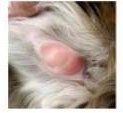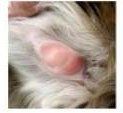Ear Care
PetPom

The
Pomeranian
Information
Center
Pomeranian Ears
Set, Size, Problems, Infection, Care, and Cleaning
Overview
There is a lot to cover in regard to Pomeranian ears, so here we will go over:
- Ear set and size, including expected variations
- Ears changes as a Pom matures
- Floppy ears
- Types of ear issues
- Details of ear infections
- Ear care & cleaning that every owner should know about
Pomeranian Ear Set and Size
Pomeranians have small, pointed, triangle shaped, erect ears. Per the AKC, they are to be "small, mounted high and carried erect. Proper ear set should be favored over size."
This means that the most important aspect is how the ears are positioned on the head, and the actual size is looked at second.
While most show Poms tend to have very small ears, you'll notice that pet Pomeranians have a wide variety of ear size, ranging from the very tiny ones that you'll see in the ring, to rather large ears that would remind one of a fox.
The size of a Pomeanian's ears is genetic; and the best way to know if your Pom will have small ears or large ears is to see the dam and sire.
The FCI calls out for Pomeranian ears to look similar to the AKC's expectations, however their vernacular is more detailed: "The small ears are set high and relatively close to each other, triangular and pointed; they are always carried upright, stiff at the tips".
In looking at a Pomeranian, if you drew lines from the inner and outer corners of the eyes, you would see that the lines flare slightly, see photo below.
-min-352x375-960w.jpg)
Changes in Ear Size and Shape from Puppy to Adult
Every Pomeranian will have their own unique ears (some small, some large, and many in between), and as a Pom matures, his ears will grow.
Often, as a puppy the ears will be very small in relation to his overall face. If he is genetically predetermined to have ears on the larger side, they will spring up to more of a point. No matter the final adult size, they should be triangle in shape, and standing erect.


Viserion, at 12 weeks old, and then as an adult Pom | Photo courtesy of Aleksandra
Puppy Earsthat Do Not Stand Erect
Puppy Ears that Do Not Stand Erect
Erect ears are such a strong trait with the Pomeranian breed that it is extremely rare for a Pom puppy to have floppy ears.
This said, it does happen every now and then. Unfortunately, in most cases this is an instance of bad breeding practices and if so, they most likely will not evolve into erect ears.
However, during the teething stage
(4 or 5 months to 8 to 9 months or so), the ears may be affected; they may stand at some times, but flop a bit
at others.
In these cases, often the muscles will strengthen, and they will stand erect for good usually by the 12 month mark.
Types of Ear Infections and Issues
There are several types of issues that may occur with the ears; some are common and others seen much less often.
We'll do an overview and then dive a bit more into ear infections, which are the most commonly seen problem.


Ear hematoma (shrivled ears)
- Hematoma is short for Aural Hematoma. 'Aural' means 'ear' and 'hematoma' means 'blood filled area'.
This occurs most often do to injury such as hitting the ear against something or for some dogs, even with excessive head shaking (which dogs often do if they have an ear infection).
With this, small blood vessels that are in the dog’s ear flap can rupture. Then, blood fills between the skin and the dog’s ear cartilage.
Ear hematoma (shrivled ears)
- Hematoma is short for Aural Hematoma. 'Aural' means 'ear' and 'hematoma' means 'blood filled area'. This occurs most often due to injury such as hitting the ear against something or for some dogs, even with excessive head shaking (which dogs often do if they have an ear infection).
With this, small blood vessels that are in the dog’s ear flap rupture. Then, blood fills between the skin and the dog’s ear cartilage.
Without prompt and proper treatment, part of the ear can shrivel, and this is commonly referred to as 'cauliflower' ear. Once this occurs, it is permanent. Therefore, identifying a hematoma and ensuring treatment is important.
Treatment involves aspirating the ear with a sterile needle, with blood and other fluids removed. A corticosteroid is then injected into the skin to reduce swelling. The ears are wrapped so that pressure keeps the spot from refilling with fluid.
For severe cases, the ear flap will be surgically opened, drained, and stitched back up. A drain will be placed in for 3 to 5 days. Prednisone may be prescribed for up to 30 days.
In 20 to 30% of cases, the hematoma will reappear. If so, treatment will be repeated.
Parasites
- This includes mites, mange, and scabies.
Ear mites
- These are one of the most common type of ear infestations and are very contagious, usually spreading to other dogs in the household.
Ear mites are tiny crab-like parasites that can invade the ear canals of dogs. The mites live on the surface of the skin in the ear canal, where they feed on tissue debris and tissue fluids, but they can also spread to the skin on the body. When this happens, there may be intense itching on the back, neck, and tail areas.
Although this can happen to a dog of any age, ear mites are more common in puppies.
Like most ear issues, signs are head shaking and trying to scratch the ears. However, with this there are also signs of blood. This can be a dark mass resembling ground coffee when you look inside the ear or it may present as a brown or black liquid.
Treatment is a pyrethrin based liquid ear solution such as Miracle Care Ear Mite Treatment , which kills ear ticks and ear mites. This is typically used for 10 days, 2 to 3 times per day. Several drops are placed into the ears, and the base is massaged.
, which kills ear ticks and ear mites. This is typically used for 10 days, 2 to 3 times per day. Several drops are placed into the ears, and the base is massaged.
With mites, you will want to machine wash everything that you can (bedding, sheets, your Pom's toys, etc.). Any cats or other dogs in the house should be treated as well, since this is highly contagious.
Mange
- Mange lives in hair follicles of virtually all dogs. A dam transmits these to her puppies within the first couple weeks of their lives. Whether they become a problem or not depends mostly on your dog's ability to keep them under control.
Problems with mange occur most often to young puppies without fully developed immune systems and senior dogs with weaker immune systems.
Signs of mange include intense itching (shaking the head, rubbing or pawing), a crusting that can be visibly seen, and hair loss.
Usually, the disease develops around the dog's face area, sometimes focused primarily on the ear area, though it can also spread to the whole body.
With pups, if the disease is localized, it will often heal on its own as puppies get older and their immune systems get stronger.
For adult dogs, it is best to have your veterinarian treat this since this involves strong scabicidal shampoos and dips.
Note that mange is not contagious.
Scabies
- This is caused by a particular mite called the sarcoptes scabiei mite, which is a highly contagious skin parasite. A scabies infection can very quickly spread from dog to dog, and can even be transmitted to cats
and humans.
The most telltale sign of scabies is constant itching and discomfort. This is most often seen on the ear flaps, chin, chest, elbows, hocks, and abdomen.
Other symptoms include crusty sores and hair loss. Some puppies or dogs also develop secondary skin infections.
Until the condition is resolved, isolate your dog from other animals and members of your household.
To treat scabies, your veterinarian will prescribe special shampoos and dips. Medicated treatment sprays may be needed to treat the entire house. Sheets, bedding, clothing, anything that can be washed in a washing machine should be done so with hot water.
Fleas - Fleas will live all over a dog's body but often cause the most itching problems in the ears; they just love the moist dark environment there. Read more:
Pomeranian with fleas
Ear Infections
- Unfortunately, most dogs will suffer from at least one ear infection in their lifetime; it is one of the most common reasons for vet visits. And some may have chronic issues.
Most infections are caused by bacteria; though yeast may also be a culprit. Ahead we will dive into this in more detail.
Pomeranian Ear Infections
Overview:
Ear infections may occur in the middle ear (otitis media) or inner ear (otitis interna) and can be quite painful.
Types:
Bacteria is the primary cause of ear infections with dogs. Though yeast and even in some cases fungi may be to blame.
Causes:
It can be tricky because two of the top elements that can cause a dog to develop an ear infection are a build-up of wax (thus requiring cleanings) and excessive cleanings. So, it is really important to clean your Pom's ears on a schedule.
Other causes include excess moisture in the ears (which is why it is important to place cotton in your Pom's ears when giving a bath), allergies, reactions to medications, thyroid disorders, viruses, autoimmune disease, endocrine disorders, and foreign bodies in the ear (small bits of grass, etc.)
Symptoms:
The most common signs of an ear infection are:
- Itchiness that manifests as head shaking, pawing at the ears, and/or rubbing the head against surfaces
- Bad odor
- Scaly skin on the inner ear flap
- Discharge
- Redness and swelling of the inner ear flap
There may also be:
- Pain when opening the mouth
- Reluctance to chew
- Tilting the head
- Leaning to the side of the affected ear
If both ears are infected, symptoms may also include wide swinging movements of the head, wobbly gait and/or hearing loss.

-min-291x335-556w.jpg)
Photo courtesy of Lauren
If you suspect that your Pomeranian may have an ear infection, it will be important to have it diagnosed as soon as possible, since it can spread (either from middle to inner ear, or from one ear to the other).
Diagnosis:
Since there are so many types of ear infections, the veterinarian will run a battery of tests. This should include:
- A visual assessment
- Gentle palpation of the ear to assess level of pain
- Examination with an otoscope to be able to look deep into the ear canal
- Microscopic examination of a tissue samples
With severe or chronic infections, x-rays and/or an MRI may be needed.

-min-251x335-486w.jpg)
Bella, photo courtesy of Cortney Pierce
Treatment:
Since ear infections can be strong and stubborn, most are treated with an aggressive course of antibiotics.
This may be a topical antibiotic such as otomax, tresaderm, panalog, or mometamx. And an oral antibiotic such as enroflaxin, orbiflaxcin, or cephalexin.
If the infection is due to yeast, an antifungal such as ketoconazole will be given.
If a puppy or dog appears to be in a lot of pain (which is common), steroids may be given, which will help with itching as well.
The vet will flush and clean a Pomeranian's ears at the office, and you will be instructed to continue doing so at home (more ahead on this) usually after a course of topical meds are complete.
The vet should ask to reexamine your Pom in 1 week.
And it can take anywhere from 10 to 30 days for an infection to clear up.
If your Pomeranian is very prone to ear infections, it will be more important than ever to be diligent in caring for them, and cleaning them.
Caring for and Cleaning Your Pomeranian's Ears
The most important aspects in regard to the ears are to keep them clean, do your best to prevent moisture from entering into the ear canal, and to inspect them on a regular basis.
Baths:
If moisture makes its way into the ear canal, it results in the perfect breeding ground for bacteria and yeast: warm, dark, and wet.
So, it is recommended to place loose pieces of cotton in your Pom's outer ear canal before you are going to give him a bath. There is no need to try and place it deep; the goal is to just have a barrier to help block water, shampoo and conditioner, and other elements from entering the ears.
Cleaning:
Some owners are hesitant to clean their dog's ears, and assume that if there are no issues, it is best to leave things as they are. And, it is true that a dog's ear wax will work to trap fine debris particles.
However, recommended protocol for proper hygiene and to help prevent ear infections is to routinely clean the ears. Ear wax (and all that trapped debris) can accumulate. And if there is infection brewing, often a cleaning can nip it in the bud before it develops into a problem requiring professional care.
If you've never done this before, don't worry. It is a very easy process. And, there is very little that can go wrong, as long as you use the right products and follow the instructions.
-min-251x335-486w.jpg)
-min-251x335-400w.jpg)
Olaf, at 2 years old, Photo courtesy of Beth Tanner
How often
- Typically, you will want to clean your Pomeranian's ears every 4 weeks. If he is prone to infections, your vet may instruct you to clean them every 2 to 3 weeks.
What you'll need: Despite the hesitation that many owners have, this is one of the quickest, easiest grooming tasks that you'll do. You only need two things:
- Sterile cotton balls (but gauze pads can work as well)
- Canine ear cleanser
You'll want a very gentle product that does not dry out the skin in the inner ear, but one that is effective (it needs to break up the wax and 'goop' in the ear, which will then come out (more ahead).
A great choice for a cleanser is Zymox Ear Cleanser With Bio-Active Enzymes ; it is both gentle and works well for prevention purposes.
; it is both gentle and works well for prevention purposes.
How to clean the ears:
There are just 3 steps:
1)
Dribble a bit of the solution into one ear at a time.
Most ear cleanser bottles come with a tapered tip, so you'll use this to drip a few drops into the canal, without sticking it deep.
2)
Massage the base of the ear. This will work the product down deep, and the massaging motion will help it to break up thick wax and pick up all the dirt and debris that is down there. You'll do this for 1 to 2 minutes.
3)
Using a cotton ball, swipe out the inner ear flap only going down as far as you comfortably can and not trying to swipe in deep. You should be picking up all sorts of brown, gray, or black stuff. Use a 2nd or even 3rd piece of cotton, until the inner flap is cleared.
You May Also Like:
A Car Seat for Your Pom
- If you'd buckle up a child, buckle up your Pom. It's a huge risk to drive your Pom without this. And, it also helps quite a bit with motion sickness.
Putting a Harness on Your Pom
- If you're not using one yet, read the reasons why these are so important.
If you email photos to us, you agree that PetPom is given free copyright to use at our discretion. We will always credit the photo to the name of the Pom's owner(s) if it is supplied.
Email: Contact@PetPom.com
All text, images and artwork protected by US and International copyright laws. All rights reserved. Copyright PetPom.com
We are a participant in the Amazon Services LLC Associates Program, an affiliate advertising program designed to provide a means for us to earn fees by linking to Amazon.com and affiliated sites.



